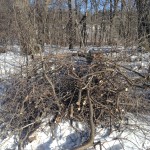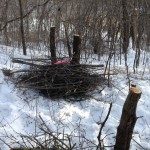In many old-growth buckthorn infestations, buckthorn berries have been dropping for years creating a significant seed bank that will germinate like crazy when the buckthorn canopy is removed and sunlight reaches the woodland understory (see NOTE below). Trying to haul buckthorn branches with berries out of the woods is difficult to do without dropping and spreading more berries, sometimes into areas beyond the original buckthorn infestation.
Buckthorn berries stacked within dense piles of buckthorn brush left in the woodland will have difficulty germinating due to lack of sun. Buckthorn seedlings that do germinate are confined to the brush pile and can be spot sprayed with a late fall foliar herbicide application. Foliar spraying in late fall protects dormant native plants and the timing makes for an efficient herbicide absorption to buckthorn roots where the plant has stored its energy.
Buckthorn brush piles provide erosion control in sloped areas. Use buckthorn stumps or other woody plants to hold brush piles in place. In time organic matter such as leaves and soil will collect in the piles making a great place for new plants to take root and enhance erosion control. Larger buckthorn trunks make an ideal foot path boundary.
Buckthorn brush piles create wildlife habitat. Many birds, including ground nesting birds like the American woodcock, rabbits, etc. will use these piles for shelter from predators. The brush acts as a mulch layer and over time will break down and return nutrients to native woodland understory plants.
Chipping buckthorn back into the woodland is another good option for large quantities of buckthorn brush if access for equipment is feasible. Just as we mulch around newly planted trees and shrubs in landscaped areas of our property, buckthorn brush mulch is very beneficial to the native plants in the woodland. Buckthorn mulch will suppress invasive plants from germinating and help retention of soil moisture.
NOTE: The biggest buckthorn removal mistake I see is removing too much buckthorn at one time, except in the case of a prairie restoration. Remove buckthorn in stages over several years or more beginning with removal of female buckthorn with berries only. Leave male and smaller buckthorn plants to shade the woodland understory while the woodland adjusts to increased sunlight. This practice will help young native plants survive and establish, and minimize the likelihood of an infestation of more non-native invasive plants.




